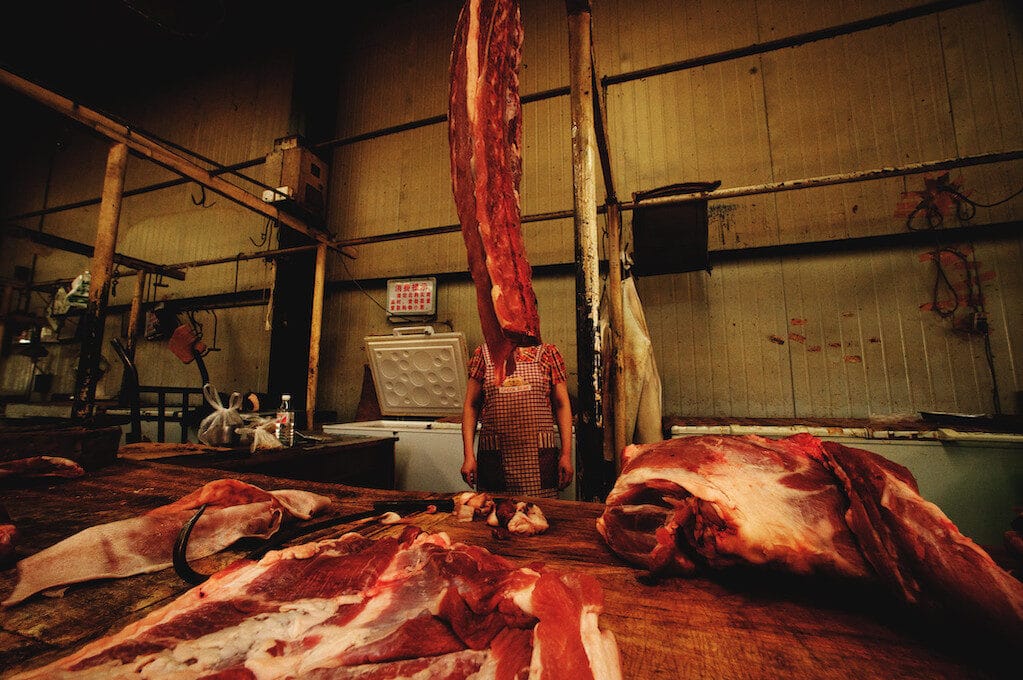The crows ate. It was fresh road kill, a raccoon, its insides a spilled soup on the road. The crows plucked at the flesh and tasted terror first, a bright-eyed beast traveling so swiftly, then regret. How could a raccoon feel regret yet not run? It stood frozen in the twin lights, tail like a stalk of corn. The crows hopped away from the raccoon, raising their wings and ramping up into the air lopsided and uneasy, memories still flickering in their heads.
Something had changed in the composition of the dead. No one really knew why, but when we ate meat, we tasted memory. Only vegans were wholly exempt. The rest of us remembered for the animals we ate—an unpleasant experience, like living inside them, like eating ourselves.
There were uprisings. What have you done to our meat! Scientists fretted in locked labs, corporate board meetings were worse than barroom brawls; everyone was miserable and afraid and trying out vegetarianism. It wasn’t so bad when you ate dairy or eggs, but there was the balmy feeling of being in utero, and that was enough to put most off.
Lots of people blamed it on GMOs or God’s general wrath, or the US of A. Others said it was pollution, something in our water or our atmosphere—maybe aliens? Still, a small minority wanted to believe it was some type of telepathic evolution, a shift in empathy, a benefit, really, if we survived the transition.
The meat industry collapsed; farmers showed up at capitol buildings in great masses demanding help, begging, lighting cars on fire. We watched on our TVs, satellite imagery from miles out in space, blazes freckling the globe.
Next came the slaughter. Knives slid through neck hide, guns loaded and loaded again, poison mixed into feed. That was probably unnecessary, not really for our safety as they said. The truth was no one wanted the livestock around anymore. What good were they to us now? A terrible reminder of their amazing taste, a satisfaction we’d never again know.
They tried all sorts of things to make it taste more like meat. But TVP is TVP, no way around it. Still, we all lost weight. Obesity rates plummeted, and cases of Type 2 diabetes and heart disease and sleep apnea. And when we ate, we tasted our own meat memories, and that was nearly the same.
The problem was the carnivorous animals. They were equally put off by the experience, going mad, eating themselves. Even as the human world reconfigured violently outside our homes, we stayed fixed to the TV, watching the countdown clock to extinction.
Popular animals like lions and tigers were some of the first to go, but there were thousands of others, pictures of them streaming the screen, and we were making donations to scientists online, and outside somewhere was a boom—and not the cheetah, the fastest animal on the planet!
It was like plunking coins into a slot machine, a waste of money, a gamble on lousy odds; still, we plunked.
As the last cheetah succumbed, a scientist held back her hair and bit into its animal flesh, crying, hardly able to swallow it down. Her colleagues looked on in horror, but surely it was just acting. They must understand—she has to remember for them all. To her surprise, the memories were not maligned with hunger. She was running, frenzied and full speed, hardly touching the scorched earth, panting, the world a Monet haze in her periphery. There was no sign of prey, only happiness, she tells the cameras in her Diane Sawyer interview, tears wrecking her eye makeup. We watched from our couches, holding tight to our memories, to each other.
Despite the slaughter, there were survivors—cattle roaming abandoned pasturelands, pigs daring deeper into the forest with each passing year. Chickens getting more aggressive, taking children’s eyes when protecting a nest.
We were happy for them, that they survived, and sorry too, that we didn’t say a thing before slaughter. But we were hungry and in bad moods. We feel better now.
–
Katie M. Flynn‘s writing has appeared in journals such as A Cappella Zoo, Barrelhouse, Bellingham Review, Fugue, and Temenos. She’s been nominated for a Pushcart Prize and holds an MFA from the University of San Francisco. She lives and writes in San Francisco still. You can follow her on Twitter: @other_katie.
Lead image: “Meat” (via Flickr user Jonathan Kos-Read)

